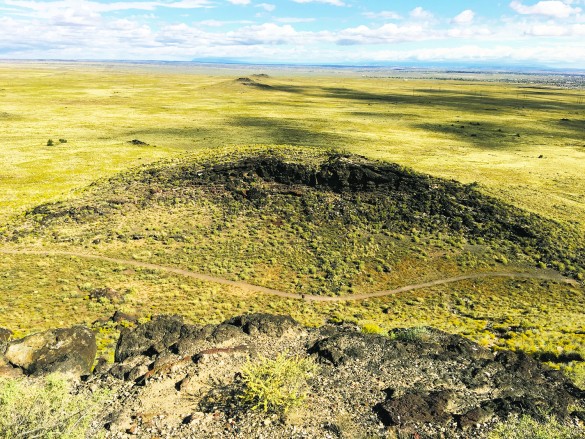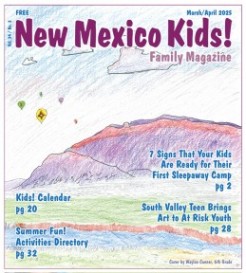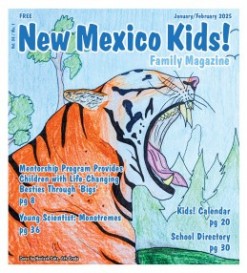Petroglyphs
Petroglyphs
July 24, 2023By EFRAIN VILLA

It can be challenging for parents to appreciate a budding artist’s creations while scrubbing walls after a child is left momentarily alone with access to markers, crayons and inviting surfaces. But it might serve as a minor consolation that long before tidy adults were trying to limit artistry to coloring within lines on paper or splashing color on canvas and screens, we humans were expressing ourselves on pretty much every surface we encountered.
Drawing on walls has been a human pastime for almost as long as humans existed. According to some experts, the earliest art discovered on cave walls might date back more than 64,000 years. All this to say: Your young artist is following in a long tradition of artmaking, so maybe a bit of historical inspiration is just what your family needs to get back to appreciating art in unlikely spaces.
In Albuquerque, we are fortunate to be able to admire the illustrations of ancient masters in an extensive archeological site right in the city’s backyard, even centuries after the indigenous artists who left their mark (in figurative and literal terms) walked these lands. On Albuquerque’s West Mesa, Petroglyph National Monument covers more than 7,200 acres of protected land and features more than 24,000 petroglyphs, carvings or drawings on volcanic rocks made by Native Americans and Spanish settlers centuries ago. In fact, the monument contains one of the largest and most important collections of ancient rock art in North America.
Although some archeologists believe the oldest petroglyphs at the park date back more than 3,000 years, it is estimated that about 90 percent of these petroglyphs were created between 1,300 AD and the end of the 17th century — a huge span of time that begins to explain the diversity in themes, styles and techniques.
One of the ways the petroglyphs were made was by using a stone chisel to chip away the rock’s dark varnish, formed by oxidation, and expose the lighter color underneath. Although the images the artists chose to depict varies, the animals, symbols and human figures help us understand the stories and traditions of the ancient people who lived in what we now know as the American Southwest. This heritage continues to be of profound significance to Native Americans and various communities throughout the world, which is one of the reasons why visiting the park today can be a deeply reflective experience for people of all ages.
In addition to the thousands of scattered petroglyphs, the monument is also home to a diverse range of plant and animal life, including several species of birds, lizards and rabbits. Some commonly spotted animals include coyotes, bobcats, snakes, prairie falcons and roadrunners. Most desert wildlife here is extremely shy, so visitors are asked to not disturb the local critters trying to go about their own business. Although instances are rare, some wildlife might become aggressive when approached and some animals carry diseases that can make humans sick, which is why it is wise to view wildlife from a safe distance.
For children learning about geology, the park offers the opportunity to explore an area created by ferocious volcanic activity millions of years ago. The remnants of these eruptions shaped the permanent natural outline of what is now Albuquerque’s western horizon; the most recognizable features to residents of the city are the three volcanic cones peeking out of the desert mesa and collectively known as the Three Sisters. A good place for geological sleuthing is in the Volcanoes Day Use Area on the west side of the national monument. Trail maps can be picked up at the visitor center.

Although visitors can drive directly to the petroglyph viewing trails, it might be a good idea to begin at the visitor center, open daily from 8:30 a.m. to 4:30 p.m. with the last entry at 4 p.m. Entrance is free. Visitor center parking is in a different area than parking for the petroglyph viewing trailheads. Although the center does not have a museum, rangers can advise visitors on how to get the most out of their visit based on physical comfort levels, party member ages and time limits. It is also where informational materials and maps can be found, including brochures in Braille. There also are a few sample petroglyphs that visitors can touch to experience the feel of these artworks. (Touching the petroglyphs on the trail can damage them.)
One popular activity is the Junior Ranger program, in which kids can earn a badge by completing a series of educational activities. The activity booklets are available online or at the visitor center. Depending on the time of year, there also are ranger-led programs for school groups that can be arranged. These programs may include hands-on activities like designing an original pictograph or petroglyph (on paper) and learning about the plants and animals that call the monument home. Upon completion, junior rangers get a badge. If the booklet is completed at home after a visit or simply as part of an off-site learning experience, the completed booklet can be emailed so a ranger can verify it and send an official badge. There also is a Senior Ranger booklet available at the visitor center, and adults receive a Senior Ranger pin upon its completion.
On the day of a family visit to the monument, it is a good idea to check the weather forecast and dress in layers, since weather on the desert mesa can change rapidly. Also, visitors should become familiar with the park’s rules and regulations, especially those relating to pets and children, such as the requirement that all children under the age of 12 be accompanied by an adult at all times. Although the park does not have food vendors, there are picnic tables, so families might want to pack snacks or a picnic. Visitors are reminded to be mindful of cleaning up all food scraps and packaging, since park maintenance resources are limited in this delicate habitat. Lastly, frequent water breaks are a good idea. It is easy to become dehydrated in the high desert’s arid climate, and parents should be aware of the limitations of little ones’ bodies, as well as their own.




